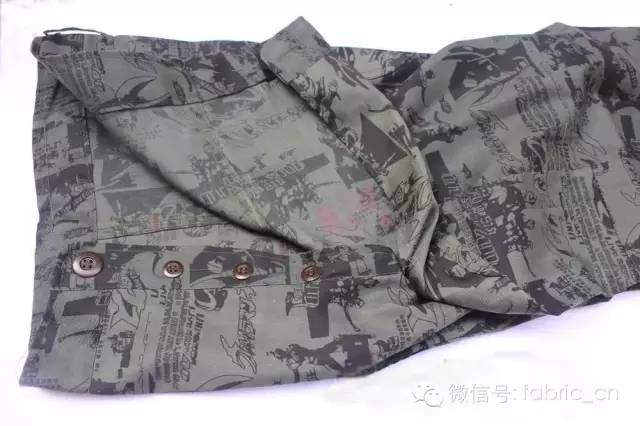However, every fiber has its advantages and disadvantages, and vinylon is no exception. Its shortcomings are reflected in the lack of bright color and poor dimensional stability; Improper control of tension, temperature, and time under wet heating conditions can easily cause problems such as hardening of the hand feel and decrease in tear strength. However, due to the use of camouflage patterns in the training uniform, there are not too many requirements for the bright luster of the fabric.

The key to the development of this product is to optimize the dyeing and finishing process, taking into account the dimensional stability, hand feel, tear strength, and flat wear resistance of the fabric. "The relevant personnel detailed the research ideas of their team. Firstly, we optimized the fineness, fracture strength, and elongation at break of polyvinyl chloride through experiments, determined the proportion of dense skin on the surface of polyvinyl chloride, and obtained reinforced fibers that balance strength, wear resistance, and fracture work.
Secondly, optimize the blending ratio among polyester, combed fine velvet cotton, and high-strength polyvinyl alcohol systems, taking into account wear resistance, dimensional stability, and comfort.
Thirdly, the design concept of using a low density roving size is adopted. Summer training uniforms achieve good breathability, while winter training uniforms achieve wind resistance through calendering treatment.
Fourthly, the quality of the summer training clothing fabric per square meter is relatively small, and it adopts two upper and lower twill weave, with an appropriate degree of tightness; The quality of the winter training clothing fabric per square meter is high, using a three up and down twill weave to reduce the number of interweaving and maintain a good hand feel.
Fifthly, avoiding wet high tension and high temperature processing conditions during dyeing and finishing can achieve good dimensional stability while also taking into account hand feel, tear strength, and wear resistance.
Sixth, digital camouflage patterns have the function of automatically converging small patterns into large-sized patterns when viewed from a distance, which can balance the camouflage effect when viewed from close and long distances. Therefore, for summer training uniforms, we adopt forest type digital camouflage patterns to adapt to the vegetation conditions of the southern and northern summer environments; The winter training uniform adopts desert digital camouflage patterns to adapt to the outdoor environmental conditions of northern winter.
Reasonable Blending Promotes Great Achievements for Civil Use
After expanding production, the application of the new training clothing fabric has been expanded, and the results show that the physical properties of the fabric are far superior to the original training clothing fabric. In terms of wear resistance indicators, the product standard specifies that the wear resistance of summer training clothing fabrics is 7.2 times higher than that of the original training clothing fabrics, and other performance has also been significantly improved. At present, the new type of training clothing fabric that has been mass-produced has good hand feel, dimensional stability, as well as good printing quality and camouflage effect.
Experts say that the pursuit of uniformity and orderliness in the fabric of military uniforms, the pursuit of firmness and firmness in the fabric of training uniforms, and the various special requirements for the fabric of special work uniforms are the difficulties in research and development, with strong demand, diverse varieties, and harsh conditions. However, whether it is regular wear, training wear, or special work wear, they have good market application prospects and the value of promoting to civil textiles, which can play a certain role in promoting the development of civil textiles.
Since any fiber material has its advantages and disadvantages, reasonable use is the key to design. "Experts further explain that vinylon fiber was once the main variety that alleviated the conflict between grain and cotton land and solved the clothing problem of the Chinese people for a while, but gradually declined and was forced to withdraw from the category of fiber consumption after the emergence and application of polyester fiber. However, considering the physical and chemical properties, processing performance, and price factors of vinylon, its application in military training clothing fabrics is suitable, and it can be said that it has achieved its strengths.
As an example of extended application, researchers have developed patrol protective clothing fabrics that can withstand tens of thousands of flat abrasions using high-strength polyvinyl chloride. The application of high-strength vinylon will go far beyond the fields of training clothing fabrics.
Basic Properties of High Strength Vinylon
Domestic high-strength vinylon is processed using a combination of wet boron spinning and formaldehyde synthesis technology, taking into account both high strength and hot water resistance, and obtaining high strength and high elongation through reasonable configuration of draft and negative draft; Adjusting the coagulation bath formula to obtain a dense skin layer of fibers for high wear resistance.
There are two specific processing routes: short fiber route and long fiber route. The high-strength vinylon produced by the short fiber route has a strength of ≥ 7.5 cN/dtex, an elongation at break of ≥ 10%, a curl count of 3/25mm~4/25mm, and a softening point in water of ≥ 112 oC; The high-strength polyvinyl chloride produced by the filament bundle route has a strength of ≥ 8.0 cN/dtex, an elongation at break of ≥ 12%, a number of curls of ≥ 15/25mm, and a softening point in water of ≥ 114 oC.